|
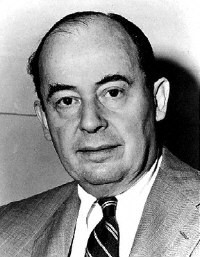
Jon von Neumann |
|
1945 John
von Neumann wrote "First Draft of a Report on the EDVAC" in which he
outlined the architecture of a stored-program computer. Electronic
storage of programming information and data eliminated the need for
the more clumsy methods of programming, such as punched paper tape --
a concept that has characterized mainstream computer development since
1945. Hungarian-born von Neumann demonstrated prodigious expertise in
hydrodynamics, ballistics, meteorology, game theory, statistics, and
the use of mechanical devices for computation. After the war, he
concentrated on the development of Princeton's Institute for Advanced
Studies computer and its copies around the world.
|
|
|
|
|
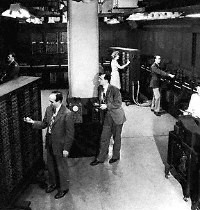 ENIAC |
|
1946 In February, the public got its
first glimpse of the ENIAC, a machine built by John Mauchly and J.
Presper Eckert that improved by 1,000 times on the speed of its
contemporaries.
|
| |
|
|
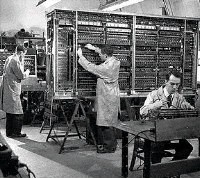
AVIDAC |
|
1946 An
inspiring summer school on computing at the University of
Pennsylvania's Moore School of Electrical Engineering stimulated
construction of stored-program computers at universities and research
institutions. This free, public set of lectures inspired the EDSAC,
BINAC, and, later, IAS machine clones like the AVIDAC. Here, Warren
Kelleher completes the wiring of the arithmetic unit components of the
AVIDAC at Argonne National Laboratory. Robert Dennis installs the
inter-unit wiring as James Woody Jr. adjusts the deflection control
circuits of the memory unit.
|
| |
|
|
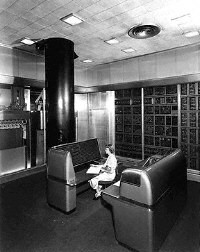 IBM's
SSEC |
|
1948 IBM's
Selective Sequence Electronic Calculator computed scientific data in
public display near the company's Manhattan headquarters. Before its
decommissioning in 1952, the SSEC produced the moon-position tables
used for plotting the course of the 1969 Apollo flight to the moon.
|
| |
|
|
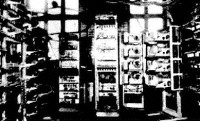
Manchester Mark I |
|
1949 The
Manchester Mark I computer functioned as a complete system using the
Williams tube for memory. This University machine became the prototype
for Ferranti Corp.'s first computer.
|
| |
|
|
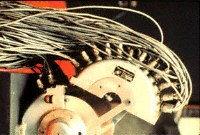 ERA
1101 Drum Memory |
|
1950 Engineering
Research Associates of Minneapolis built the ERA 1101, the first
commercially produced computer; the company's first customer was the
U.S. Navy. It held 1 million bits on its magnetic drum, the earliest
magnetic storage devices. Drums registered information as magnetic
pulses in tracks around a metal cylinder. Read/write heads both
recorded and recovered the data. Drums eventually stored as many as
4,000 words and retrieved any one of them in as little as
five-thousandths of a second.
|
| |
|
|
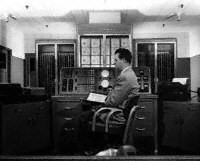 SWAC |
|
1950 The
National Bureau of Standards completed its SWAC (Standards Western
Automatic Computer) at the Institute for Numerical Analysis in Los
Angeles. Rather than testing components like its companion, the SEAC,
the SWAC had an objective of computing using already-developed
technology.
|
| |
|
|
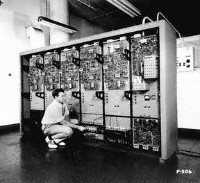
MIT Whirlwind |
|
1951 MIT's
Whirlwind debuted on Edward R. Murrow's "See It Now" television
series. Project director Jay Forrester described the computer as a
"reliable operating system," running 35 hours a week at 90-percent
utility using an electrostatic tube memory.
|
|
|
|
|
 von
Neumann's IAS |
|
1951 The
UNIVAC I delivered to the U.S. Census Bureau was the first commercial
computer to attract widespread public attention. Although manufactured
by Remington Rand, the machine often was mistakenly referred to as the
"IBM UNIVAC." Remington Rand eventually sold 46 machines at more than
$1 million each
|
|
|
|
|
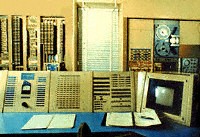 SAGE
Operator Station |
|
1956 MIT
researchers built the TX-0, the first general-purpose, programmable
computer built with transistors. For easy replacement, designers
placed each transistor circuit inside a "bottle," similar to a vacuum
tube. Constructed at MIT's Lincoln Laboratory, the TX-0 moved to the
MIT Research Laboratory of Electronics, where it hosted some early
imaginative tests of programming, including a Western movie shown on
TV, 3-D tic-tac-toe, and a maze in which mouse found martinis and
became increasingly inebriated.
|
|
|
|
|
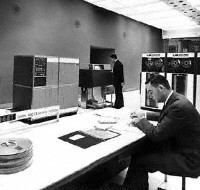 IBM
1401 |
|
1961 According
to Datamation magazine, IBM had an 81.2-percent share of the computer
market in 1961, the year in which it introduced the 1400 Series. The
1401 mainframe, the first in the series, replaced the vacuum tube with
smaller, more reliable transistors and used a magnetic core memory.
Demand called for
more than 12,000 of the 1401 computers, and the machine's success made
a strong case for using general-purpose computers rather than
specialized systems.
|
|
|
|
|

IBM System/360 |
|
1964 IBM
announced the System/360, a family of six mutually compatible
computers and 40 peripherals that could work together. The initial
investment of $5 billion was quickly returned as orders for the system
climbed to 1,000 per month within two years. At the time IBM released
the System/360, the company was making a transition from discrete
transistors to integrated circuits, and its major source of revenue
moved from punched-card equipment to electronic computer systems.
|
|
|
|
|
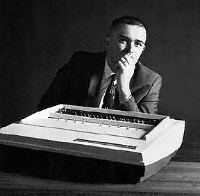 Ed de
Castro and Nova |
|
1968 Data
General Corp., started by a group of engineers that had left Digital
Equipment Corp., introduced the Nova, with 32 kilobytes of memory, for
$8,000.
|
|
|
|
|
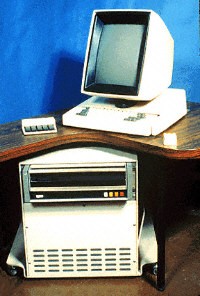 Xerox
Alto |
|
1974 Researchers
at the Xerox Palo Alto Research Center designed the Alto -- the first
work station with a built-in mouse for input. The Alto stored several
files simultaneously in windows, offered menus and icons, and could
link to a local area network. Although Xerox never sold the Alto
commercially, it gave a number of them to universities. Engineers
later incorporated its features into work stations and personal
computers
|
|
|
|
|
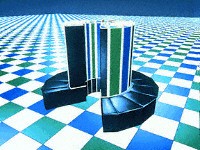 Cray I |
|
1976 The
Cray I made its name as the first commercially successful vector
processor. The fastest machine of its day, its speed came partly from
its shape, a C, which reduced the length of wires and thus the time
signals needed to travel across them
|
|
|
|
|
 VAX
11/780 |
|
1978 The
VAX 11/780 from Digital Equipment Corp. featured the ability to
address up to 4.3 gigabytes of virtual memory, providing hundreds of
times the capacity of most minicomputers
|
|
|
|
|
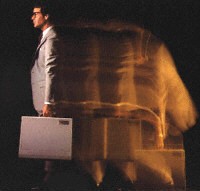 Compaq
PC Clone |
|
1983 Compaq
Computer Corp. introduced first PC clone that used the same software
as the IBM PC. With the success of the clone, Compaq recorded
first-year sales of $111 million, the most ever by an American
business in a single year.
|
|
|
|
|
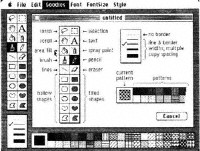 Apple
Macintosh |
|
1984 Apple
Computer launched the Macintosh, the first successful mouse-driven
computer with a graphic user interface, with a single $1.5 million
commercial during the 1984 Super Bowl. Based on the Motorola 68000
microprocessor, the Macintosh included many of the Lisa's features at
a much more affordable price: $2,500.
|
|
|
|
|
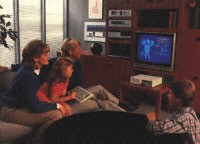 IBM PC
Jr. |
|
1984 IBM
released its PC Jr. and PC-AT. The PC Jr. failed, but the PC-AT,
several times faster than original PC and based on the Intel 80286
chip, claimed success with its notable increases in performance and
storage capacity, all for about $4,000. It also included more RAM and
accommodated high-density 1.2-megabyte 5 1/4-inch floppy disks
|
|
|
|
|
 IBM PS/2 |
|
1987 IBM
introduced its PS/2 machines, which made the 3 1/2-inch floppy disk
drive and video graphics array standard for IBM computers. The first
IBMs to include Intel's 80386 chip, the company had shipped more than
1 million units by the end of the year. IBM released a new operating
system, OS/2, at the same time, allowing the use of a mouse with IBMs
for the first time.
|
|
|
|
|
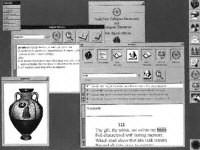 NeXT |
|
1988 Apple
co-founder Steve Jobs, who left Apple to form his own company,
unveiled the NeXT. The computer he created failed but was recognized
as an important innovation. At a base price of $6,500, the NeXT ran
too slowly to be popular. The significance
of the NeXT rested in its place as the first personal computer to
incorporate a drive for an optical storage disk, a built-in digital
signal processor that allowed voice recognition, and object-oriented
languages to simplify programming. The NeXT offered Motorola 68030
microprocessors, 8 megabytes of RAM, and a 256-megabyte read/write
optical disk storage.
|